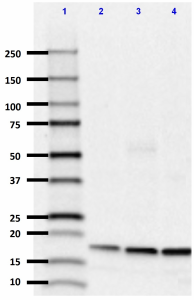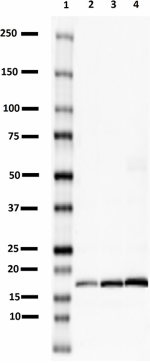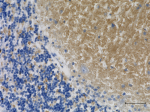- Clone
- SP10 (See other available formats)
- Regulatory Status
- RUO
- Other Names
- Vesicle-associated membrane protein 1, synaptobrevin-1
- Previously
-
Covance Catalog# MMS-616R
- Isotype
- Mouse IgG2b, κ
- Ave. Rating
- Submit a Review
- Product Citations
- publications

-

Western blot of anti-Synaptobrevin (VAMP) antibody (clone SP10). Lane 1: Molecular weight marker; Lane 2: 20 µg of human brain lysate; Lane 3: 20 µg of mouse brain lysate; Lane 4: 20 µg of rat brain lysate. The blot was incubated with a 1:2000 dilution of the primary antibody overnight at 4°C, followed by incubation with HRP labeled goat anti-mouse IgM. Enhanced chemiluminescence was used as the detection system.
| Cat # | Size | Price | Quantity Check Availability | Save | ||
|---|---|---|---|---|---|---|
| 837001 | 500 µL | £299 | ||||
Synaptobrevins, also known as VAMPs, along with syntaxins and the synaptosomal-associated protein SNAP25, form the protein complex that is involved with the docking and fusion of synaptic vesicles with the presynaptic membrane. Synaptobrevins have a molecular weight of 18 kD, and are also involved in the formation of the SNARE complexes. The synaptobrevins are degraded by the protein tetanospasmin, from the tetanus-causing bacterium Clostridium tetani, as well as botulinum toxin from Clostridium botulinum.
Product DetailsProduct Details
- Verified Reactivity
- Human, Mouse, Rat
- Antibody Type
- Monoclonal
- Host Species
- Mouse
- Immunogen
- This antibody was raised against a crude synaptic preparation of post mortem human brain.
- Preparation
- Ascites
- Concentration
- The concentration is not quantified as this product is sold as undiluted crude mouse ascites fluid. The concentration might vary from lot-to-lot and an estimated concentration would be 1-3 mg/ml.
- Storage & Handling
- Store at -20°C. Upon initial thawing, apportion into working aliquots and store at -20°C. Avoid repeated freeze-thaw cycles to prevent denaturing the antibody. For long-term storage, keep the antibody at -80°C.
- Application
-
WB - Quality tested
IHC-P, ELISA, ICC - Reported in the literature, not verified in house - Recommended Usage
-
Each lot of this antibody is quality control tested by Western blotting. For Western blotting, the suggested dilution of this reagent is 1:1000 - 1:2000. It is recommended that the reagent be titrated for optimal performance for each application.
- Application Notes
-
SP10 reacts with native, denatured and recombinant synaptic vesicle proteins synaptobrevin/VAMP-1 (aa 1-118) and VAMP-2 expressed in a bacterial system (aa 33-96). The antibody is particularly valuable for immunocytochemical studies of the brain due to its stability in formalin sections.
-
Application References
(PubMed link indicates BioLegend citation) -
- Sawada K, et al. 2002. Mol Psychiatry 7:484-92. (WB, IHC-P, ELISA)
- Honer WG, et al. 2002. Cerebral Cortex 12:349-56. (WB, ELISA, ICC)
- Honer WG, et al. 1993. Brain Res. 609:9-20. (ICC)
- Poon VY, et al. 2014. Front. Cell Neurosci. 8:66. (ICC) PubMed
- Product Citations
-
- RRID
-
AB_2565369 (BioLegend Cat. No. 837001)
Antigen Details
- Structure
- Synaptobrevin 1 (VAMP1) is a 118 amino acid protein with an apparent molecular mass of 13kD. Synaptobrevin 2 (VAMP2) is a 116 amino acid protein with an apparent molecular mass of 12.5 kD.
- Biology Area
- Cell Biology, Neuroscience, Synaptic Biology
- Molecular Family
- Presynaptic proteins
- Gene ID
- 6843 View all products for this Gene ID
- UniProt
- View information about Synaptobrevin on UniProt.org
Related Pages & Pathways
Pages
Related FAQs
Other Formats
View All Synaptobrevin (VAMP) Reagents Request Custom Conjugation| Description | Clone | Applications |
|---|---|---|
| Anti-Synaptobrevin (VAMP) | SP10 | WB,IHC-P,ELISA,ICC |
| Purified anti-Synaptobrevin (VAMP) | SP10 | WB,IHC-P,ELISA,ICC |
Compare Data Across All Formats
This data display is provided for general comparisons between formats.
Your actual data may vary due to variations in samples, target cells, instruments and their settings, staining conditions, and other factors.
If you need assistance with selecting the best format contact our expert technical support team.
-
Anti-Synaptobrevin (VAMP)

Western blot of anti-Synaptobrevin (VAMP) antibody (clone SP... -
Purified anti-Synaptobrevin (VAMP)

Western blot of purified anti-Synaptobrevin (VAMP) antibody ... 
IHC staining of purified anti-Synaptobrevin (VAMP) antibody ... 
IHC staining of purified anti-Synaptobrevin (VAMP) antibody ... 
IHC staining of purified anti-Synaptobrevin (VAMP) antibody ...
 Login / Register
Login / Register 












Follow Us